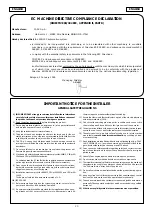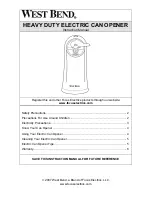
2 0
Ground Rod
Tips for proper ground installation:
• Use a ground rod to provide a ground reference.
• Consult your city code and be aware of under-ground
services in the site of the gate operator to prevent
inconveniences.
• Always use a single bonding point for grounding.
• All ground wires must be as short and as thick as
possible.
• Prevent unnecessary turns or loops in all ground
wires.
Solar Panel Safety Precautions
!
Installation must be performed by a qualified technician.
• Before installing your system, contact local authorities and determine the
necessary permit, installation and inspection requirements.
• Follow all local codes and guidelines.
• To reduce the risk of electrical shock or burns, the solar panel must be covered
with an opaque material during installation.
• Do not touch live terminals with bare hands as they can present a risk of electrical
shock, burn or fire.
ELECTRICAL INSTALLATION
Solar Panel Care and Location
• Where it will receive maximum sunlight throughout the year.
• Avoid trees and buildings or obstructions, which could cast shadows on the panel.
• South facing and tilted at an inclined angle that is equal to latitude.
• If dirt build-up becomes excessive, clean the glass with a soft cloth using a mild
detergent and water.
• Install solar panels in the following conditions:
• Operating temperature:
-40°F to 185°F
• Humidity:
Below
85RH%
• Wind pressure:
Below 50.12lb / ft
²
(2400Pa)
• Snow load pressure:
Below 112.76lb / ft
²
(5400Pa)
• DO NOT install the solar panel near open flames or flammable materials.
• DO NOT install the solar panel where there is a risk of being immersed in water or
continually exposed to water from a sprinkle, fountain, etc..
Solar Panel Installation
(per article 690 of ANSI/NFPA 70)
• Use appropriate methods to mount the solar panel. Fall of the panel from high
places will cause death, injury or damage.
• The solar panel must be mounted on a post with a supporting structure to support
wind and snow loads rated for use by the appropriate local or civil codes.
• Use stainless steel washers between the panel and the supporting frame to prevent
electrolysis corrosion.
• Use conduit and the appropriate wire type for outdoor applications.
• Properly ground solar panel and operator according to NEC code.
• Use the appropriate wire size according to distance and the maximum power
(Watt) rating of the solar panel, or panels combined.
• Use at least 16 AWG photovoltaic cable or 90°C, sunlight and moisture resistant
direct burial cable or better.
• WARNING - This charge controller must be used with an external GFDI device as
required by article 690 of the National Electric Code for the installation location.
www.PerformanceGateOpeners.com | (800) 878-7829 | [email protected]
















































